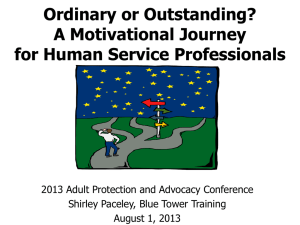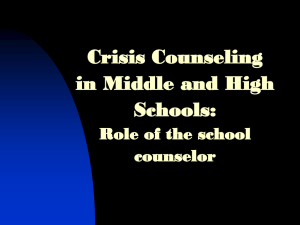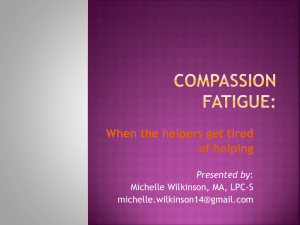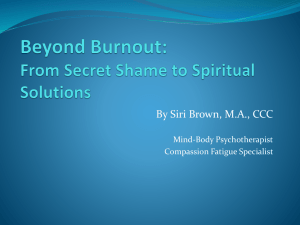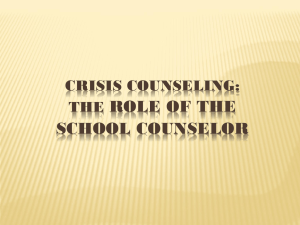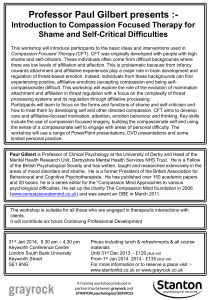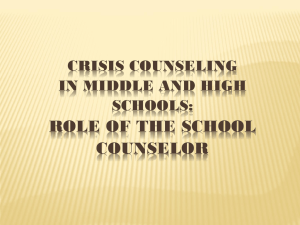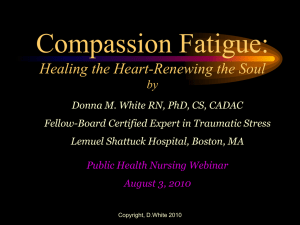Compassion fatigue
advertisement
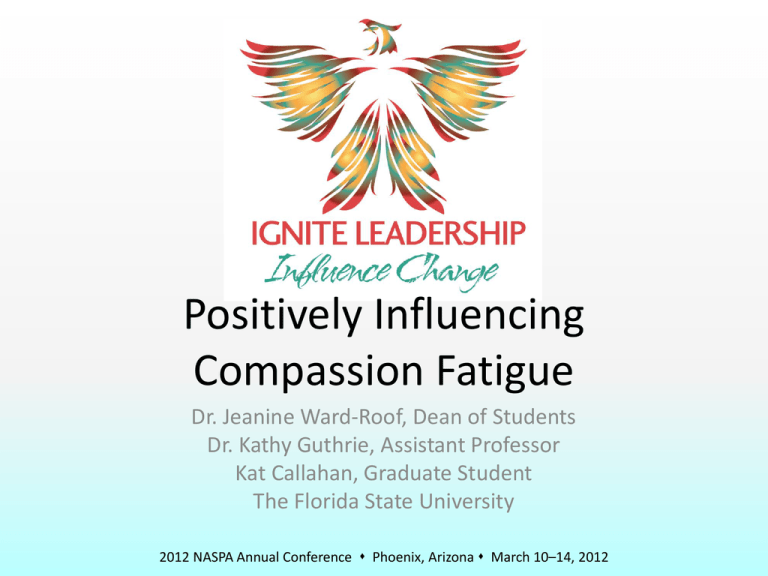
Positively Influencing Compassion Fatigue Dr. Jeanine Ward-Roof, Dean of Students Dr. Kathy Guthrie, Assistant Professor Kat Callahan, Graduate Student The Florida State University 2012 NASPA Annual Conference s Phoenix, Arizona s March 10–14, 2012 What is Compassion Fatigue? • Johnson (1992) – A unique form of burnout – Coined the term compassion fatigue in article discussing nurses reactions to handling constant emergencies • Figley (1995;2002) & Stamm (2010) – Reduced capacity to be empathic to those we serve – Due to exposure to suffering – Two facets • Secondary trauma • Job burnout Compassion Fatigue • Figley (1982;2002) & Stamm (2010) – Term Compassion Fatigue well-known in fields of psychology and traumatology • Hoffman, etc. al (2007) – Recovery rate is faster than burnout with appropriate interventions • Kanter (2007) – Treatment for compassion fatigue is non-specific Compassion Fatigue and Student Affairs • Research focused in health fields but believe parallels can be made to Student Affairs workers. • Bender (2009), Boehman (2007) & Lorden (2009) – Retention of student affairs professionals is low • Questions – As Student Affairs work becomes more complex, is compassion fatigue a contributing factor to the retention rates? – How can one manage environments to lessen compassion fatigue? Research Methodology • Purpose: – To explore perceptions of student affairs professionals of the compassion fatigue concept. • Online study included pilot and full study – Random sampling of 2000 NASPA members from across the Nation • 184 responded – Collected demographic information and initial reactions, opinions and options for further involvement in the study • Two phases – Qualitative survey – Interviews Participant Demographics • Institution – Type • • • • • • Public – 63% Private – 30% 2-yr. –3% 4-yr. – 55% Rural – 12% Urban – 22% – Size • Small-under 5000 – 19% • Medium-5,001-15,000 – 28% • Large-over 15,001 – 52% • Gender – – Females – 57% Male – 42% • Career – – – 0-10 years – 24% 11-20 years – 37% 21+ years – 30% • Sampling of Titles: – VPSA, Dean of Students, Faculty members, Greek Life, New Student and Family Programs, Student Affairs Coordinators, Hall Directors, Activity Coordinators and Academic Advisors Survey Results • Results suggest – Little is known about the concept of compassion fatigue • 52 respondents specifically stated they did not fully understand the concept – “I have not heard of this concept before today” – “I have very little understanding of this concept” • Three main themes emerged from research: – Student Affairs profession is not fully aware of compassion fatigue concept – Professional burnout is tangentially associated with compassion fatigue – Methods to manage compassion fatigue vary Survey Results • Participants responded: – Own awareness is highest • 53% responded high or very high – Institutional awareness is low • 85% responded low or very low – Awareness within the profession is low • 67% responded low or very low Survey Results • Answering “What is your perception of the influence of compassion fatigue in the student affairs profession? – “I don’t think I have every heard of this concept, but it makes sense that it exists and I certainly witness times when I believe my colleagues experience this.” – “I don’t think there is much awareness of the concept of compassion fatigue in student affairs.” – “The concept makes sense, but [is] not formally talked about or discussed.” Survey Results • Answering “What is your perception of the influence of compassion fatigue in the student affairs profession?” – “I think people mistake compassion fatigue for burnout and vice versa. I know I combine these concepts incorrectly all of the time” – Professionals stated a clear cause-and-effect relationship between burnout and compassion fatigue • “Burnout is a problem for Student Affairs Professionals, which leads to compassion fatigue.” • “I think burnout results in high compassion fatigue and leads to higher turnover rates. I think it makes professional less effective” Survey Results • Answering “How do you MANAGE environments that may lead to compassion fatigue?” – Self-management of compassion fatigue was higher than office management • 83% indicated self had high to very high ability to cope with elements that potentially foster compassion fatigue • 50% indicated office had high to very high and 50% indicated office had low to very low ability to cope with elements that potentially foster compassion fatigue Survey Results • Answering “How do you MANAGE environments that may lead to compassion fatigue?” – “Management of compassion fatigue is the ultimate challenge, particularly those in high level leadership positions. I am always looking for new methods” – “I have no idea how to manage it. It is challenging, this is for sure.” – “I manage through self-reflection activities. It is important to remember why we do what we do and to not lose sight of the educational moment even if it appears that we feel like a broken record.” Survey Results – Phase 2 • Participants were asked to describe: – Reason for ratings of office awareness, institutional awareness and student affairs professional awareness of compassion fatigue – How compassion fatigue manifests in Student Affairs – How we can manage and eliminate compassion fatigue Survey Results – Phase 2 • Framework – What is compassion fatigue? – Never heard of compassion fatigue – Compassion fatigue equals burnout – Compassion fatigue is: • “burnout is a sense of finality, fatigue is when the candle is flickering and [you wonder] how to get it out of the wind and to have healthy ways to manage” Survey Results – Phase 2 • Answering “How does compassion fatigue manifest?” – – – – – – – – – – Impatience with student problems “quicker to judge” Self pity and sharing it with everyone “No communication” Incivility “Jaded” “Light leaves your eyes” Addiction to work Burnout and leaving the field Compassion fatigue impacts the office dynamics Survey Results – Phase 2 • Major Themes – Student Affairs is a 24/7 job and most of us feel the need to match our lifestlye spending 60-80 hours working, checking email, texting with students, going to events (especially in housing and student activities) – “We had to do it, so new professionals have to” mind set – Talk about wellness, but no follow-through – We are losing some of the best professionals to burnout – When people are fatigued they cannot contribute to the team as well, affects dynamics of the staff Survey Results – Phase 2 • Answering “How can we manage and eliminate compassion fatigue?” – More information about compassion fatigue – Manual for supervisors on compassion fatigue • Methods to train new staff, how to prevent and eliminate compassion fatigue, provide safe environments – Encourage the field to “talk” about it more – Walk the talk – be a role model for students and new professionals. – Encourage each other – be accountable to one another Implications • Should not shy away from topic, but have more conversation about how this affects our profession and professionals working in this area. • Being more aware of compassion fatigue may lead to increased work satisfaction • Developing strategies for dealing with compassion fatigue may lead to lower turnover of student affairs professionals • More research is needed on ways to raise awareness about and reduce levels of compassion fatigue Discussion – Create a plan for addressing compassion fatigue on a personal level and within a work environment Irrational Beliefs and Conclusions • Selected Irrational Beliefs of Student Affairs Workers (author unknown) – My job is my life. – In my position, I must be totally competent, knowledgeable, and able to help everyone. I must always perform at a peak level with a lot of energy and enthusiasm. – Getting any form of negative feedback indicates that there is something wrong with what I am doing. – Faculty, students, and staff are by their nature difficult. They should be more involved in my program. – To be able to accomplish my job for my own sense of self-worth, I must be liked and respected by everyone with whom I work. – My negative feelings about my job and the work environment come from external pressures. Therefore, there is nothing I can do to relieve the feelings of depression, hostility and hopelessness that are contributing to my burnout. Resources • • • • • • • • • Bender, B. E. (2009). Job satisfaction in student affairs (2009). NASPA Journal, 46(4), 553-565. Boehman, J. (2007). Affective commitment among student affairs professionals. NASPA Journal, 44(2), 307-325. Figley, C.R. (Ed.) (1995). Compassion Fatigue: Secondary Traumatic Stress Disorders from Treating the Traumatized. New York: Brunner/Mazel. Figley, C.R. (1995). Compassion fatigue as a secondary traumatic stress disorder: An overview. In C.R. Figley (Ed.), Compassion fatigue: Coping with secondary traumatic stress disorder in those who treat the traumatized (p. 1-20). New York: Brunner. Figley, C.R. (2002). Compassion fatigue and the psychotherapist’s chromic lack of self care. Journal of Clinical Psychology, 58(11), 1433-1441. Hoffman, S., Palladino, J.M., Barnett, J. (2007). Compassion fatigue as a theoretical framework to help understand burnout among special education teachers. Journal of Ethnographic and Qualitative Research, 2, 15-22. Kanter, J. (2007). Compassion fatigue and secondary traumatization: A second look. Clinical Social Work Journal, 35, 289-293. Lorden, L. P. (2009). Attrition in the student affairs profession (2009). NASPA Journal, 35(3), 207-216. Stamm, B. (2002). Measuring compassion satisfaction as well as fatigue: Development history of the compassion satisfaction and fatigue test. In C.R. Figley (Ed.), Treating Compassion Fatigue (pp. 107-122). New York: Brunner-Routledge. Can’t be in two places at once? Now you can! 2012 NASPA Annual Conference DVD-ROM SPECIAL ONSITE PRICE of $89 (plus S&H) * Includes 80 sessions Audio recordings + synchronized slide * presentations from a select number of * presenters Mac and PC compatible Order Now! Price increases to $139 after the conference! This exclusive offer is brought to you by *The data DVD-ROM is meant to be used ONLY on computers with DVD-ROM drives. The product will ship approx. 6-8 weeks after the conference ends. Note – special pricing available for onsite purchases only, price will increase after conference ends.
